
Trams are a major form of public transport in Melbourne, the capital city of the state of Victoria, Australia. As of May 2017, the Melbourne tramway network consists of 250 kilometres of double track, 493 trams, 24 routes, and 1,763 tram stops. The system is the largest operational urban tram network in the world. Trams are the second most used form of public transport in overall boardings in Melbourne after the commuter railway network, with a total of 206 million passenger trips in 2017–18.

The Sandringham line is a commuter railway line in the city of Melbourne, Victoria, Australia. Operated by Metro Trains Melbourne, it is the city's fourth shortest metropolitan railway line at 17.9 kilometres (11.1 mi). The line runs from Flinders Street station in central Melbourne to Sandringham station in the south-east, serving 14 stations via South Yarra, Balaclava, Elsternwick, and Brighton. The line operates from approximately 5am to 12am, daily, with 24 hour service available on Friday and Saturday nights. Services run every 7–8 minutes during peak hour, with services running every 15 minutes during the inter-peak period on weekdays, and every 20 minutes at night and during the day on weekends. Additionally, services run every 60 minutes overnight on Friday and Saturday nights as part of the Night Network.
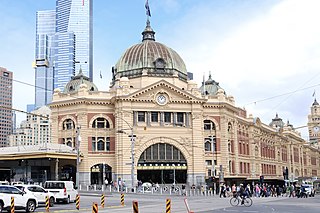
The Melbourne rail network is a passenger and freight train system in the city of Melbourne, Victoria, Australia. The metropolitan passenger rail network is centred on the Melbourne CBD and consists of 222 stations across 16 lines, which served a ridership of 99.5 million over the year 2021–2022. It is the core of the larger Victorian railway network, with links to both intrastate and interstate systems.
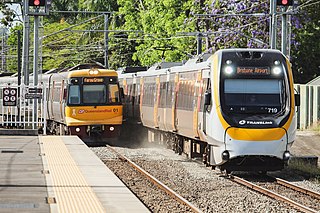
Rail transport in Australia is a component of the Australian transport system. It is to a large extent state-based, as each state largely has its own operations, with the interstate network being developed ever since Australia's federation in 1901. As of 2022, the Australian rail network consists of a total of 32,929 kilometres (20,461 mi) of track built to three major track gauges: 18,007 kilometres (11,189 mi) of standard gauge, 2,685 kilometres (1,668 mi) of broad gauge, and 11,914 kilometres (7,403 mi) of narrow gauge lines. Additionally, about 1,400 kilometres (870 mi) of 610 mm / 2 ft gauge lines support the sugar-cane industry. 3,488 kilometres (2,167 mi), around 11 per cent of the Australian heavy railways network route-kilometres are electrified.
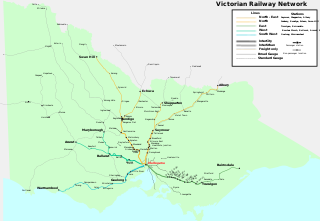
Rail transport in the Australian state of Victoria is provided by a number of railway operators who operate over the government-owned railway lines. The network consists of 2,357 km of Victorian broad gauge lines, and 1,912 km of standard gauge freight and interstate lines; the latter increasing with gauge conversion of the former. Historically, a few experimental 762 mm gauge lines were built, along with various private logging, mining and industrial railways. The rail network radiates from the state capital, Melbourne, with main interstate links to Sydney and to Adelaide, as well as major lines running to regional centres, upgraded as part of the Regional Fast Rail project.

Station Pier is a historic Australian pier on Port Phillip, in Port Melbourne, Victoria. Opened in 1854, the pier is Melbourne's primary passenger terminal, servicing interstate ferries and cruise ships, and is listed on the Victorian Heritage Register.
Australians generally assumed in the 1850s that railways would be built by the private sector. Private companies built railways in the then colonies of Victoria, opened in 1854, and New South Wales, where the company was taken over by the government before completion in 1855, due to bankruptcy. South Australia's railways were government owned from the beginning, including a horse-drawn line opened in 1854 and a steam-powered line opened in 1856. In Victoria, the private railways were soon found not to be financially viable, and existing rail networks and their expansion were taken over by the colony. Government ownership also enabled railways to be built to promote development, even if not apparently viable in strictly financial terms. The railway systems spread from the colonial capitals, except for a few lines that hauled commodities to a rural port.

The Victorian Railways (VR), trading from 1974 as VicRail, was the state-owned operator of most rail transport in the Australian state of Victoria from 1859 to 1983. The first railways in Victoria were private companies, but when these companies failed or defaulted, the Victorian Railways was established to take over their operations. Most of the lines operated by the Victorian Railways were of 5 ft 3 in. However, the railways also operated up to five 2 ft 6 in narrow gauge lines between 1898 and 1962, and a 4 ft 8+1⁄2 instandard gauge line between Albury and Melbourne from 1961.

Bairnsdale railway station is the terminus of the Gippsland line in Victoria, Australia. It serves the city of Bairnsdale, and it opened on 8 May 1888.
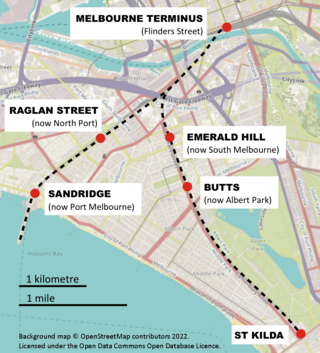
The Melbourne and Hobson's Bay Railway Company was a railway company in Victoria, Australia. The company was incorporated on 20 January 1853 to build the line from Melbourne to the port of Sandridge, now Port Melbourne.

The Hawthorn Bridge crosses the Yarra River, five kilometres (3.1 mi) east of Melbourne, Victoria, Australia, connecting Bridge Road and Burwood Road. It is the oldest extant bridge over the Yarra River and is one of the oldest metal bridges in Australia. It was constructed in the early wave of major new infrastructure funded by the Victorian gold rush. Designed by Francis Bell, it is a substantial riveted, wrought iron, lattice truss structure, with bluestone abutments and piers.

The A2 class was an express passenger locomotive that ran on Victorian Railways from 1907 to 1963. A highly successful design entirely the work of Victorian Railways' own design office, its long service life was repeatedly extended as the Great Depression and later World War II delayed the introduction of more modern and powerful replacement locomotives.

A public transport timetable is a document setting out information on public transport service times. Both public timetables to assist passengers with planning a trip and internal timetables to inform employees exist. Typically, the timetable will list the times when a service is scheduled to arrive at and depart from specified locations. It may show all movements at a particular location or all movements on a particular route or for a particular stop. Traditionally this information was provided in printed form, for example as a leaflet or poster. It is now also often available in a variety of electronic formats.

The Metropolitan Transit Authority (MTA), known to the general public as The Met, was a Government of Victoria owned corporate body that operated suburban passenger trains, trams and buses in Victoria, Australia. It was set up under Section 15 of the Transport Act 1983 and commenced operation on 1 July 1983. It was a statutory body set up to manage the trams formerly operated by the Melbourne & Metropolitan Tramways Board, the metropolitan train operations of the former VicRail, and the operations of the former Melbourne Underground Rail Loop Authority.
The Mont Park railway is a former branch line from the Hurstbridge line in Melbourne, Australia. The main line connection was at the up (Melbourne) end of Macleod station, with the line operating between 1911 and 1964.

Sir Harold Winthrop Clapp KBE was a transport administrator who over the course of thirty years had a profound effect on Australia's railway network. In two decades as its Chairman of Commissioners, he revolutionised Victorian Railways, with unprecedented attention to customer service and innovations such as more powerful locomotives, air-conditioned carriages, and faster services culminating in the introduction of the flagship Spirit of Progress express train. Seconded to the Federal Government in World War II, he played a pivotal role in the manufacture of fighter aircraft in the defence of Australia. As Director-General of Australia's Land Transport Board, he presented a report on railway gauge standardisation that ultimately led to the eventual linking of all Australian mainland capital cities by a uniform track gauge.
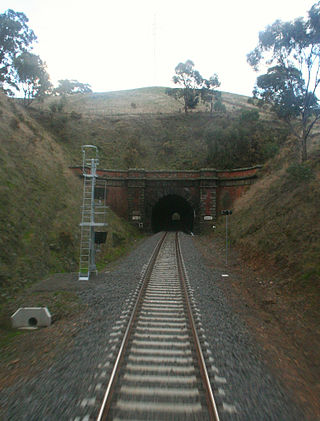
The Australian state of Victoria has only ever had about 10 tunnels on its railway network, with some others on private narrow gauge tramways. This is due to the relatively easy terrain through which most of the lines were built.
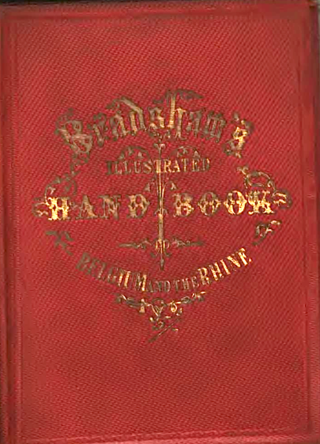
Bradshaw's was a series of railway timetables and travel guide books published by W.J. Adams and later Henry Blacklock, both of London. They are named after founder George Bradshaw, who produced his first timetable in October 1839. Although Bradshaw died in 1853, the range of titles bearing his name continued to expand for the remainder of the 19th and early part of the 20th century, covering at various times Continental Europe, India, Australia and New Zealand, as well as parts of the Middle-East. They survived until May 1961, when the final monthly edition of the British guide was produced. The British and Continental guides were referred to extensively by presenter Michael Portillo in his multiple television series.

The European Rail Timetable, more commonly known by its former names, the Thomas Cook European Timetable, the Thomas Cook Continental Timetable or simply Cook's Timetable, is an international timetable of selected passenger rail schedules for every country in Europe, along with a small amount of such content from areas outside Europe. It also includes regularly scheduled passenger shipping services and a few coach services on routes where rail services are not operated. Except during World War II and a six-month period in 2013–14, it has been in continuous publication since 1873. Until 2013 it was published by Thomas Cook Publishing, in the United Kingdom, and since 1883 has been issued monthly. The longstanding inclusion of "Continental" in the title reflected the fact that coverage was, for many years, mostly limited to continental Europe. Information on rail services in Great Britain was limited to only about 30 pages until 1954 and then omitted entirely until 1970. June 2011 marked the 1500th edition.
The Katamatite railway line is a disused railway located in northern Victoria, Australia. It was built as a tramway, running from Dookie to Katamatite, and opened on 11 August 1890. Two years later it was taken over by the Victorian Railways (VR) and sections of the track were upgraded allowing its reclassification as a railway. The line was formally closed on 13 January 1987.
















